#Polykleitos the Younger
Photo
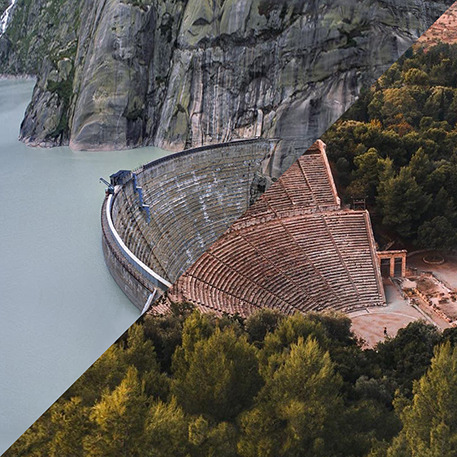
Spitallamm dam, Grimselsee, Switzerland, 1932
VS
Ancient Theatre, Epidaurus, Greece, 4th century BC
#Spitallamm#Grimselsee#dam#Arch dams#Hydropower#barrage#architecture#engineering#Epidaurus#greece#ancient greece#theatre#ancient theatre#Polykleitos the Younger#Pausanias#argolis#archaeology#greek archaeology#landscape architecture#Asclepius#World Heritage Site#UNESCO
940 notes
·
View notes
Text
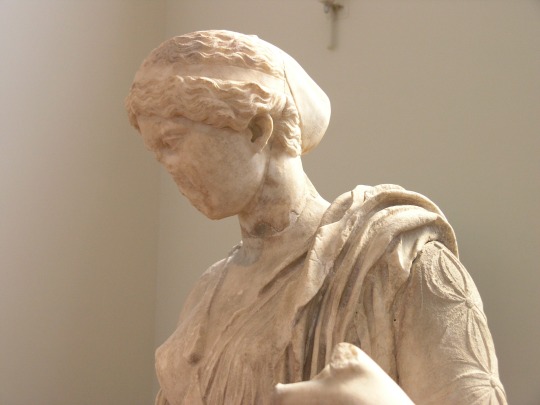

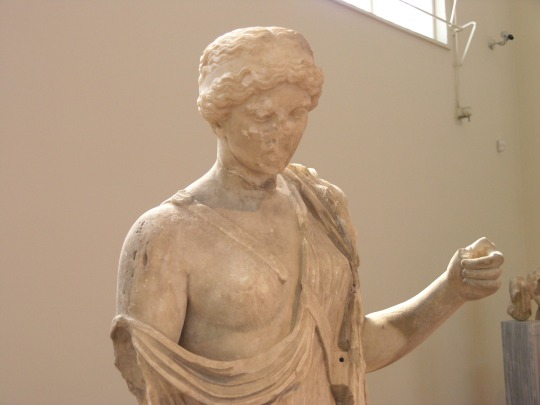

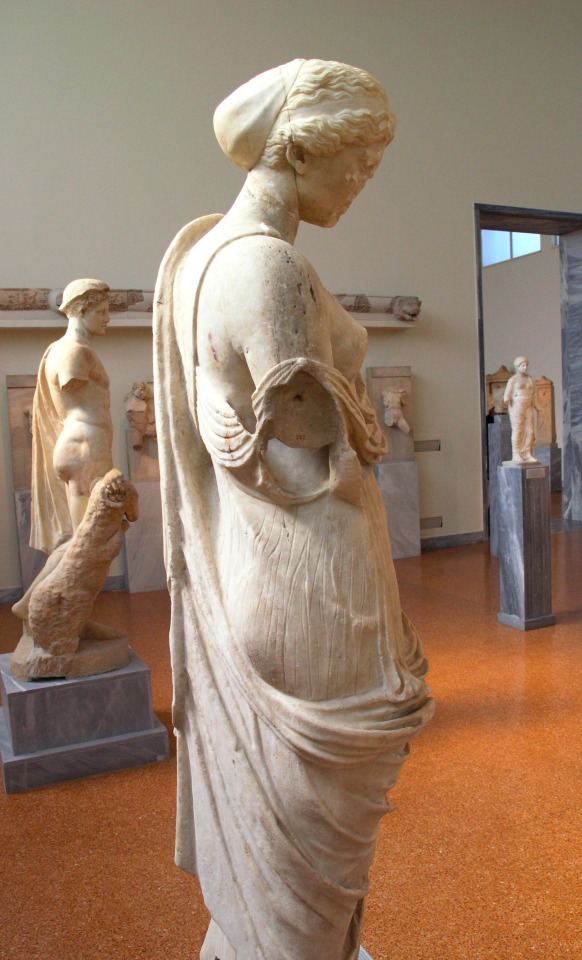




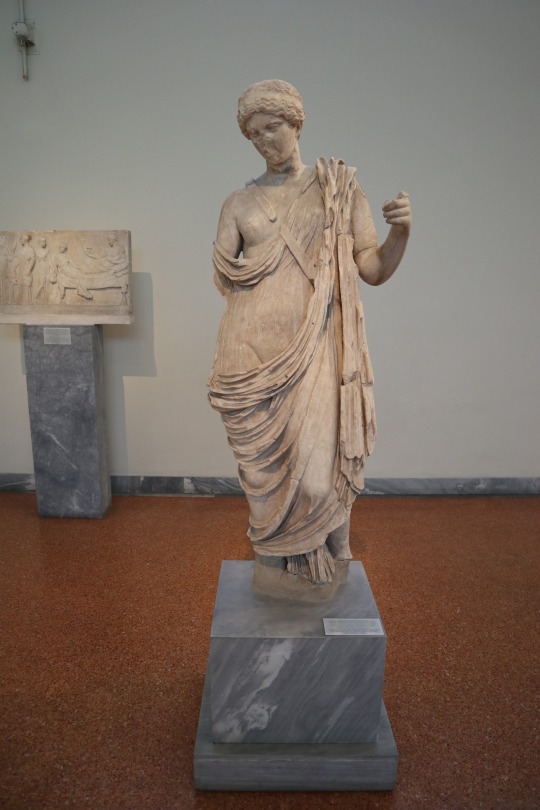
Aphrodite Areia, 1st C. CE copy of 400 BCE statue by the school of Polykleitos, possibly Polykleitos the Younger. National Archaeological Museum in Athens (see NAMA 262).
"The Temple of Aphrodite Kytherea was a sanctuary in ancient Kythira dedicated to the Goddess Aphrodite. It was famous for reportedly being the eldest temple of Aphrodite in Greece. It was dedicated to the Goddess under her name and aspect as Aphrodite Ourania and contained a statue of an Armed Aphrodite. The temple is dated to the 6th century BCE. While considered a significant sanctuary, it was described as a small building.
According to Hesiod, Kythira was the first island that Aphrodite passed as she rose from the sea.
Herodotus (Histories 1.105.3) described it:
"This temple, I discover from making inquiry, is the oldest of all the temples of the Goddess, for the temple in Cyprus was founded from it, as the Cyprians themselves say; and the temple on Cythera was founded by Phoenicians from this same land of Syria."
Pausanias (Description of Greece, 3.23.1 & 1.14.7) also said of it:
"In Kythera [off the coast of Lakedaimonia] is . . . the sanctuary of Aphrodite Ourania (the Heavenly) is most holy, and it is the most ancient of all the sanctuaries of Aphrodite among the Greeks. The Goddess herself is represented by an armed image of wood. This is the only temple I know that has an upper storey built upon it.
...a sanctuary of the Heavenly Aphrodite; the first men to establish her cult were the Assyrians, after the Assyrians the Paphians of Cyprus and the Phoenicians who live at Ascalon in Palestine; the Phoenicians taught her worship to the people of Cythera."
Aphrodite Areia (Ancient Greek: Ἀφροδίτη Ἀρεία) or "Aphrodite the Warlike" was a cult epithet of the Greek Goddess Aphrodite, in which she was depicted in full armor like the war God Ares. This representation was found in Sparta and Taras (modern Taranto). There were other, similarly martial interpretations of the Goddess, such as at her Sanctuary at Kythira, where she was worshiped under the epithet Aphrodite Urania, who was also represented as being armed. The epithet "Areia", meaning "warlike", was applied to other Gods in addition to Aphrodite, such as Athena, Zeus, and possibly Hermes.
The association with warfare contradicts Aphrodite's more popularly known role as the Goddess of desire, fertility, and beauty. In the Iliad, Aphrodite is portrayed as incompetent in battle, being wounded in the wrist by Diomedes under the guidance of Athena, and she is reminded of her role as a love Goddess rather than a war Goddess like Athena by Zeus. It is possible, however, that this representation was deliberate to assert the Ionian interpretation of Aphrodite, which did not portray the Goddess with warlike aspects, as the "correct" version.
It is believed that the warlike depiction of Aphrodite belongs to her very earliest acolytes and cults in Cyprus and Cythera, where there was a strong eastern influence during the Orientalizing Period. This depiction can trace Aphrodite's descent from older Middle Eastern Goddesses such as the Sumerian Inanna, Mesopotamian Ishtar, and Phoenician Astarte. In Cyprus, Aphrodite was also referred to by the epithet "Aphrodite Encheios" (Aphrodite with a spear), and it has been suggested that the cult was brought from Cyprus to Sparta. She was also known by this name on the Areopagus and at Corinth.
There were cults dedicated to the warlike aspect of Aphrodite in Kythira, Cyprus, Argos, Taras and most prominently in Sparta.
Pausanias recorded that three cult statues at Kythira, Sparta, and Corinth depicted Aphrodite as holding weapons and archeological evidence points to this portrayal also occurring in Argos. Pausanias' claim that "Aphrodite Areia" was simply a female version of Ares has some support in the contemporary epigraphy.
In Sparta, Pausanias described two temples dedicated to Aphrodite Areia and archeological evidence supports this claim. Various authors make reference to Sparta worshipping an armoured Aphrodite, such as Plutarch, Nonnos, and Quintilian. Pausanias' claim that "Aphrodite Areia" was simply a female version of Ares has some support in the contemporary epigraphy. A related Spartan epithet, "Armed Aphrodite" (Ἀφροδίτη 'Ενόπλιος) was associated with an etiological myth recorded by Lactanius, who stated that once the Spartan army was away from the city attacking Messene, part of the Messene army launched a counterattack against Sparta that was thwarted by the Spartan women who armed themselves and defended the city. The Spartan army, realizing their city was under siege, returned and assumed that the women were the enemy army until they stripped off their armour to reveal their identities. It is likely that this myth was used to explain the origin of an unknown Spartan festival that functioned similarly to the Argive festival of Hybristica, where women took over the roles of men.
In Argos, Aphrodite Areia appears to be related to Nikephoros ("victory bearer") and in a nearby city of Manteneia, there was a temple devoted to both Aphrodite and Ares."
-taken from wikipedia
#aphrodite#venus#ancient greece#pagan#paganism#european art#antiquities#sculpture#literature#history#statue#art#museums
128 notes
·
View notes
Text
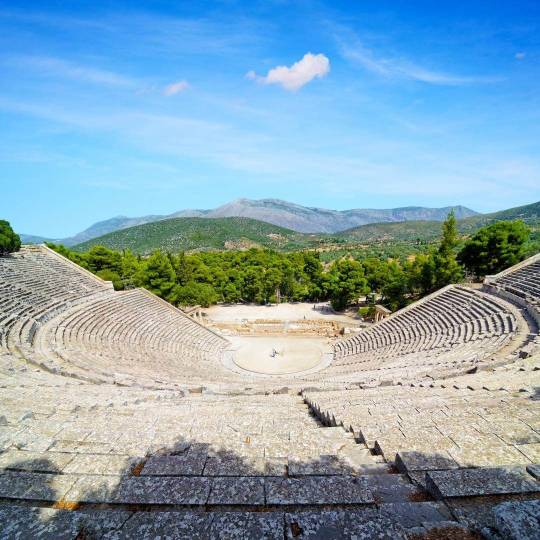
The Ancient Theatre of Epidaurus is a theatre in the Greek city of Epidaurus, located on the southeast end of the sanctuary dedicated to the ancient Greek God of medicine, Asclepius. It is built on the west side of Cynortion Mountain, near modern Lygourio. It is considered to be the most perfect ancient Greek theatre with regard to acoustics and aesthetics.
The ancient theatre was constructed at the end of the 4th century BC by the architect Polykleitos the Younger. At a maximum capacity of 13,000 to 14,000 spectators, the theatre hosted music, singing and dramatic games that were included in the worship of Asclepius. It was also used as a means to heal patients since there was a belief that the observation of dramatic shows had positive effects on mental and physical health.
Today, the monument attracts a large number of Greek and foreign visitors and is used for the performance of ancient drama plays. The first modern performance conducted at the theatre was Sophocles's tragedy, Electra. It was played in 1938, directed by Dimitris Rontiris, starring Katina Paxinou and Eleni Papadaki.
Performances stopped due to World War II. Theatrical performances, in the framework of the organized festival, began again in 1954. In 1955 they were established as an annual event for the presentation of ancient drama. The Epidaurus Festival continues today and is carried out during the summer months.
The theatre has been sporadically used to host major musical events. In the framework of the Epidaurus Festival, well-known Greek and foreign actors have appeared, including the Greek soprano Maria Callas, who performed Norma in 1960 and Médée in 1961.
#goexploregreece#greece#travel#mustsee#mustvisit#greek#europe#beautiful views#holiday#travel destinations#traveller#beautiful photos#ancient buildings
29 notes
·
View notes
Text

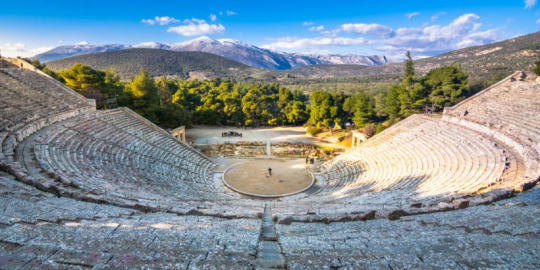
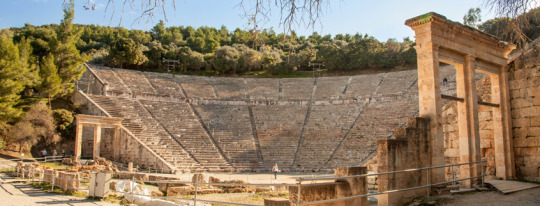
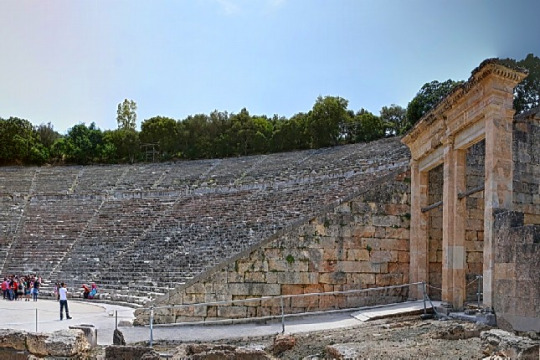
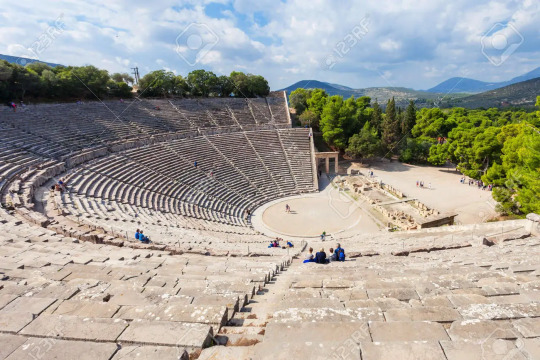
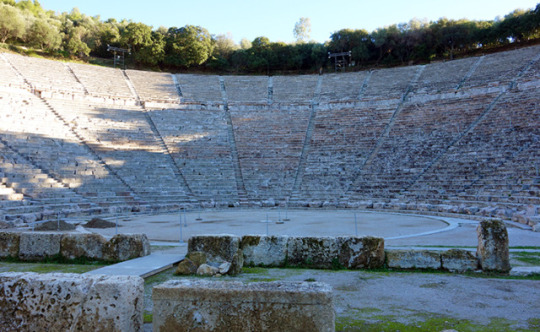
The ancient Greek theater of Epidaurus, a work of the architect Polykleitos the Younger (late 4th century BCE).
7 notes
·
View notes
Text
Famous people
Tag list of famous people from Ancient Rome and Greece. A few hellenistic rulers and some Etruscans are also included.
And for some reason the page is not working properly. The HTML code is there, but it only works on my dashboard. On this page links are inactive. I figure that page only understands “/tagged/Agrippina-the-Elder” - versions, but I’m too lazy / busy to rewrite the code. So if you want to check a tag, you’ll have to copy and paste it after the word “ .../tagged/”. And same goes for all the lists below.
URLs + copy&paste:
https://romegreeceart.tumblr.com/tagged/
https://romegreeceart.tumblr.com/archive/tagged/
A
Aelia Flaccilla- Pillar of the Church
Agrippina the Elder
Agrippina the Younger
Aemilia Lepida and her descendants v emperor Nero
Aeschylus
Aetius
Alaric
Alcibiades
Alexander the Great
Ancus Marcius
Antinous
Antiochus I Soter
Antiochus III the Great
Antisthenes (philosopher, cynic school)
Antonia Minor - mother of Claudius and Germanicus
Antoninus Pius
Apicius
Apollodorus of Damascus
Apollonius of Tralles (Greek sculptor)
Aristotle
Arsinoe II
Arsinoe III
Artemisia II of Caria
Aspasia
Atticus (Cicero’s friend)
Attila
Augustus
Aulus Rustius Verus (Pompeian politician)
Aurelianus
B
Baltimore painter (Apulia, 4th century BCE)
Berenike II
Britannicus
Brygos Painter
Brutus (liberator, founder of the republic)
Brutus (assassin)
C
Caesarion
Caligula
Callimachus
Caracalla
Carausius (Roman Britain, emperor)
Carinus
Cassius Dio
Catiline
Cato the Elder
Cato the Younger
Cicero
Claudia Antonia (emperor’s daughter)
Claudius
Claudius Gothicus
Cleopatra
Cleopatra Selene
Cleopatra III
Clodius Albinus
Commodus
Constantine the Great
Constantius II
Constantius Chlorus
Corbulo
Cornelia Africana
Cornelia Minor (Caesar’s wife)
Crispina
Crispus (Constantine’s eldest son)
Croesus
Cynisca (Spartan princess, olympic winner)
D
Darius III
Decius
Demosthenes
Didia Clara (daughter of Didius Julianus)
Didius Julianus
Diocletianus
Dioscorides Pedanius (physician, botanist)
Diva Claudia (daughter of Nero)
Domitianus
Drusus Caesar (son of Germanicus)
Drusus the Younger (son of Tiberius)
Drusus the Elder (son of Livia)
E
Elagabalus
Eumachia (Pompeian priestess and patroness)
Euripides
F
Fabius Maximus Cunctator (”The Shield of Rome”)
Faustina Maior
Faustina Minor
Female painters
Flavian dynasty
G
Gaius Caesar
Galerius
Galba
Galen
Galla Placidia
Gallic emperors
Gallienus
Germanicus
Gelon
Gens Aemilia
Gens Cornelia
Gens Calpurnia
Geta
Gordian I
Gordian II
Gordian III
Gracchi Brothers
Gratian
Greek tyrants
H
Hadrianus
Hannibal
Hegias (Greek sculptor, 5th century BCE
Hellenistic kings
Herennius Etruscus (co-emperor)
Hermione Grammatike
Herodes Atticus
Herodotus
Hippocrates
Historians
Homeros
Honorius
Hostilianus
I
Iaia of Cyzicus (female painter)
Jovianus
Juba II
Julia (Augustus’ daughter)
Julia Aquilia Severa (Vestal virgin and empress)
Julia Domna
Julia Drusilla
Julia Felix (Pompeian business woman)
Julia Flavia (Titus’ daughter)
Julia Maesa
Julia Soaemias
Julian the Apostate
Julio-Claudian family (julioclaudian)
Julio-Claudian dynasty
Julio-Claudian
Julio-Claudian dynasty
Julius Caesar 1
Julius Caesar (2)
Julius Vindex
K
Kings
Kresilas (Athenian sculptor)
Kritios (Athenian sculptor)
L
Lady of Aigai
Lady of Vix (Celtic woman, late 6th century BCE)
Lassia (priestess of Ceres, Pompeii)
Lepidus
Leonidas
Livia
Livilla
Livius
Lucilla (daughter of Marcus Aurelius)
Lucius Appuleius Saturninus
Lucius Caecilius Jucundus (Pompeian banker)
Lucius Caesar
Lucius Herennius Flores (Boscoreale Villa, real owner ?)
Lucius Verus
Lysippos
Lysippos 2
M
Maecenas
Macrinus
Magnus Maximus
Mamia (Pompeian priestess and patroness)
Marcellus (Augustus’ heir)
Marcus Agrippa
Marcus Antonius
Marcus Aurelius
Marcus Claudius Tacitus (emperor)
Marcus Licinius Crassus
Marcus Terentius Varro
Marius
Martialis
Masinissa
Maussollos of Halicarnassos
Maxentius
Maximianus
Maximinus Daia
Maximinus Thrax
Members of imperial families
Menander
Miami painter
Milonia Caesonia
Miltiades (Greek general)
Mona Lisa of Galilee
Myron
N
Nero
Nero Julius Caesar (son of Germanicus)
Nerva
Nerva-Antonine family
Numa Pompilius
O
Octavia the Younger (Augustus’ sister)
Octavia (Claudius’ daughter)
Optimates
Otho
Ovidius
P
Paionios (Greek sculptor)
Patronesses
Penthesilea painter
Pericles
Pertinax
Pescennius Niger
Pheidias
Philip the Arab
Philosophers
Philip II of Macedonia
Phryne (Greek courtesan)
Plancia Magna
Plato
Pliny the Elder
Pliny the Younger
Poets
Polykleitos
Pompeius
Poppaea Sabina
Populares
Postumus Agrippa
Postumus (Gallic emperor)
Probus
Ptolemy of Mauretania
Praxiteles
Ptolemy I
Publius Clodius Pulcher
Publius Fannius Synistor
Publius Licinius Crassus (triumvir’s younger son)
Publius Sittius
Publius Quinctilius Varus
Pythagoras
Pyrrhus
Pytheas (a greek explorer)
Q
Queens
R
Roman Caesars (= princes, heirs to the throne)
Roman Civil War Commanders
Roman client kings
Roman consuls
Roman dictators
Roman emperors
Roman empresses
Roman generals
Roman gentes
Romans who declined the throne
Romulus Augustulus
Romulus and Remus
S
Sabina
Sallustius
Sappho
Scipio Africanus
Scopas
Sejanus
Septimius Severus
Seven sages
Severan dynasty
Severus Alexander
Sextus Pompeius
Shuvalov painter
Silanion ( Greek sculptor)
Socrates
Solon
Sophocles
Stilicho
Strabo
Sulla
Sulpicia (Roman female poet)
T
Tacitus
Tarpeia
Tarquinius Superbus
Themistocles
Theodosius
Theophrastus
Thucydides
Tiberius
Tiberius Claudius Verus (Pompeian politician)
Tigranes the Great
Titus
Titus Labienus
Titus Tatius
Titus Quinctius Flaminius
Trajanus
Trebonianus Gallus
Tribunes of the plebs
U
Ulpia Severina (interim sovereign in 275 CE)
Urban prefects
Usurpers
V
Vaballathus (Palmyran king)
Valens
Valentinianus I
Valentinianus III (murderer of Aetius)
Valerianus
Valeria Messalina
Vel Saties
Velia Velcha (“Mona Lisa of antiquity”)
Velimna family (Hypogeum, Brescia)
Vercingetorix
Vergilius
Vespasianus
Vibia Sabina
Vipsania Agrippina
Viriathus (Lusitanian freedom fighter)
Vitellius
Volusianus
X
Xenophon
Y
Z
Zenobia
183 notes
·
View notes
Photo
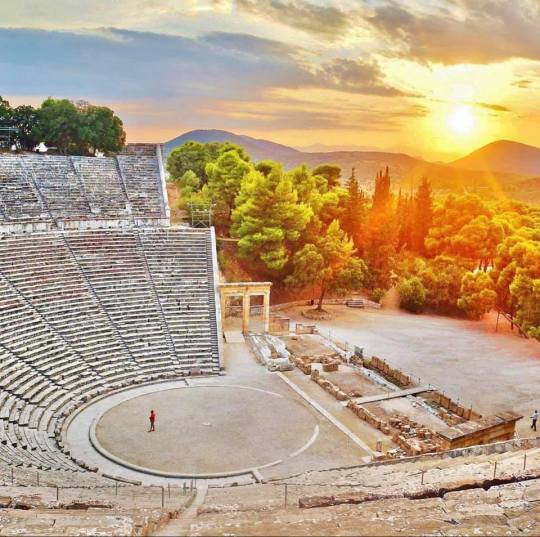
The Ancient Theatre of Epidaurus, Greece.
The theatre was constructed at the end of the 4th century BC by the architect and sculptor Polykleitos the Younger.
20 notes
·
View notes
Photo

Greek theater of Epidaurus. #Greece. 360 BC. The theater was built by the architect Polykleitos the Younger. https://www.instagram.com/p/CDcdmPYl952/?igshid=mrkh38n43qms
85 notes
·
View notes
Text
THE TOWNLEY COLLECTION
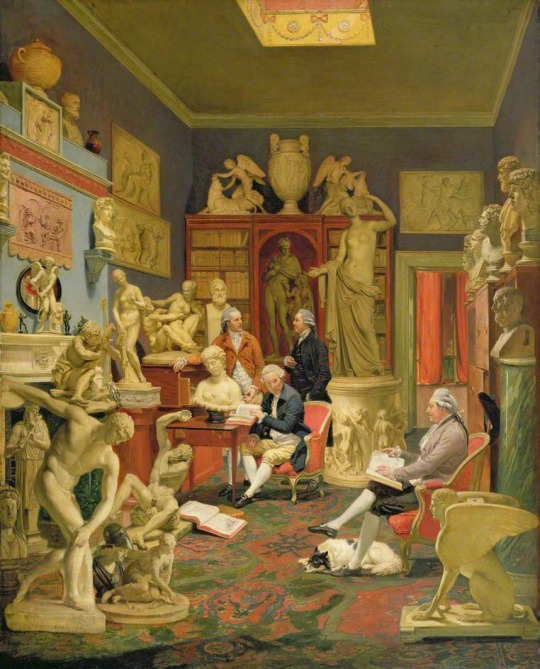
above: Johann Zoffany, Charles Townley and his Friends in the Towneley Gallery, 33 Park Street, Westminster, 1781-83, Towneley Hall Art Gallery and Museum.
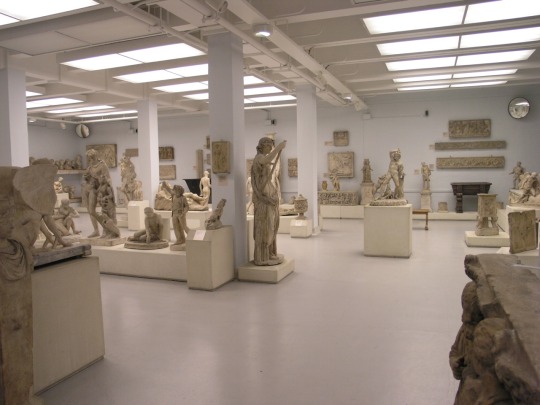



Charles Townley 1737-1805) acquired the scultptures, paintings, manuscripts, coins and gems that formed his celebrated collection over the course of three tours of Italy. Buying from Italian collectors and working with Scottish antiquities dealer, Gavin Hamilton, Townley acquired masterpieces of Roman art including a copy of Myron’s Discorbolos (smuggled out of the Villa Adriana by Hamilton), the bust of Antonia the Younger (identified as Clytie at the time), the Boys Fighting over Knucklebones (attributed to Polykleitos by Winckelmann); and the Towneley Vase. Among the most admired antiquities of the period, plaster casts were made and sold of many of Townley’s marbles (Goethe owned two plasters replicas of the “Clytie”).
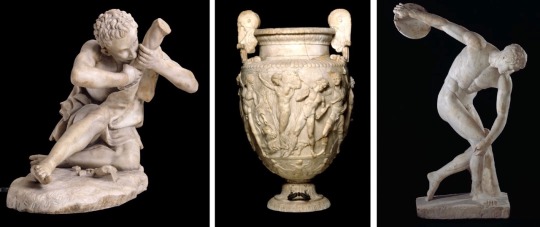
The Townley collection is the subject of a “conversation piece,” painted by Johann Zoffany in 1782. Townley described the commission in a letter: “Mr Zoffany is painting, in the Stile of his Florence tribune, a room in my house, wherein he introduces what Subjects he chuses in my collection. It will be a picture of extraordinary effect & truth.” Zoffany imagined Townley and two fellow antiquarians in a room surrounded by highly-accurate renderings of 40 works from the collection. Although those objects were never displayed in that room or in that manner, the picture captures the period ideal of lively intellectualism and urbane sociability engendered by the experience of classical culture.
On the strength of his collection, Townley became a member of the Society of Dilettanti in 1786 and, in 1791, he was inducted into the Royal Society and made a trustee of the British Museum. According to his wishes, the collection was sold to the British Museum after his death in 1805, with the stipulation that it be exhibited in a dedicated gallery. Completed in 1814, the Townley bequest was followed immediately by the museum’s acquisition of the Parthenon sculptures in 1816. These additions necessitated the rebuilding of the museum on a larger scale. Today, the majority of the Townley Collection is displayed in crowded basement galleries of the museum, overshadowed by the Parthenon sculptures. The installation of the galleries has, ironically, reified Zoffany’s fiction.
49 notes
·
View notes
Text
Ancient Greece Travel Journal

Site: Delphi
Location: Delphi, Greece
The first site that I visited in my travel back to Ancient Greece is the important ancient Greek religious sanctuary Delphi that was sacred to the ancient Greeks, but specifically Apollo. The site was first settled in Mycenaean times in the late Bronze Age (around 1,500-1,100 B.C.E) but took on its religious significance from around 800 B.C.E in ancient Greece times. The original name of the sanctuary was actually Pytho after the snake which Apollo was believed to have killed there. Delphi was also once considered to be the center of the world, for in Greek mythology the greek god Zeus released two eagles, one to the east and one to the west, and Delphi was the point at which the birds met each other after each encircled the world. As far as events that took place at this site, Delphi was similar to many other religious sites in that it held panhellic games to honor various gods of the Greek religion. The Pythian Games of Delphi began sometime between 591 and 585 BCE and were initially held every eight years, with the only event being a musical competition where solo singers accompanied themselves on a kithara to sing a hymn to Apollo. Later, more musical contests and athletic events were added to the program, and the games were held every four years with only the Olympic Games being a more important event. When I first approaced Delphi, however, the first thing that I saw was the sanctuary of Athena Pronaia. Some of the people that I encountered in my travel to this particular location were Greeks going to worship Apollo, and the conversations I heard from those around me were mostly about the upcoming Pythian games and what was going to happen in them. This site was most relevant to ancient greeks who used it mainly for athletic events like the Pythian games, or for religious purposes such as worshipping or honoring the greek god Apollo. It was a significant development in building this site for the greeks as it became home to many different events ranging from religious to athletic. Overall visiting Delphi was a unique experience due to its wide range of events that took place there.
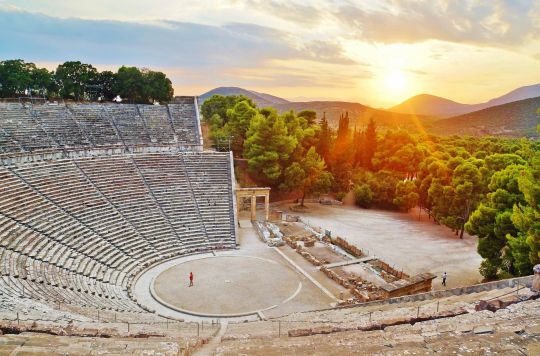
Site: Ancient Epidaurus Theater
Location: Epidavrou, Tripolis, Greece
The second location that I visited as I embarked on my traveling journey through ancient Greece was the ancient Epidaurus Theater located in Tripolis, Greece. This ancient theater home to the Greeks is the most beautiful and most preserved of its kind, according to expert historians. The theater was said to be built in the 4th century B.C.E, more specifically 340 B.C.E, by Polykleitos the younger. It was built in two phases; one during the 4th century BC and the second in the mid-2nd century; and divided into two parts: one for citizens and one for priests and authorities. The theater is even still used today due to its excellent accoustics and condition. Located in the eastern part of the Peloponnese, the Sanctuary of Asclepius at Epidaurus was an important sacred healing center during ancient times. Asclepius, also spelled Asklepios, was believed to possess healing powers that he learned from his father, Apollo. Due to this being the case, the theater attracted people from all over Greece who came to be treated by the resident priests. As far as events and what took place here goes, the theater was mainly used for therapuetic and religious purposes in honor of the god of healing, Asklepios. During my visit there, I encountered all kinds of people from all over Greece, but particularly soldiers and family members of soldiers and other greeks who fought in the Peloponnesian war and were still alive and were looking for healing for their wounds and losses from the war because it had ended about 60 years before the theater was built. They made their way to the theater to worship the god of healing. As far as the sounds that I heard, it was mostly quiet as a lot of the conservations around me were Greeks who were looking for healing or peace and prosperity. This site was a significant development for the ancient Greeks because it was built as both a healing and therapuetic center for Greek citizens but also as a place to honor the god of healing in doing so. It was relevant to all Greek citizens, but specifically those who needed healing or peace from wars or military campaigns. Overall this theater was unique because of its amazing accoustics and sound, but also for the way that many sought healing and therapy when visiting here.

Site: Mt. Lycabettus
Location: Athens, Greece
The next location I visited was neither a theater or an oracle, but rather a famous hill or mountain in the capital of Greece, Athens. Mt. Lycabettus, also known as Lycabettus Hill, is the highest of Athens’ Hills. According to greek mythology, the hill was created by the greek goddess Athena, when she dropped a piece of limestone accidentally and that’s how the hill came into existence. Other stories suggest that it was once the refuge of wolves, which is possibly the origin of its name, as wolves means lycos in greek. Lycabettus Hill is unique compared to the other locations in that in ancient times, it never bore very many special traces of human activity or events due to its steep shape. As far as people I encountered, I only encountered a few other ancient Greeks who came there to hike to the top and to pay their respects to the greek goddess Athena. It was relevant to many cultures in that it was a sacred hill, but it most relevant to the ancient greeks and greek mythology due to its unique origins of Athena being credited with making it, albeit accidentally. It didn’t quite seem like a significant development for the Greeks at the time, but as time went on it began to grow in popularity as a theater was built in it in the second century B.C.E, and many travelers, tourists, and citizens continue to hike it to this day as it has become an increasingly popular tourist destination, according to historians. Once I hiked to the top of Lycabettus Hill, I could see everything as far as the Northern suburbs of Greece all the way to the sea. Overall Lycabettus was a unique traveling experience for me due to the fact that its history isn’t closely tied with human activity or special events like the theater or oracles I visited before this, but it still has an important greek tie to greek mythology, and more specifically Athena.

Site: Dodona Oracle
Location: Epirus, Greece
The fourth location that I visited in my journey back in time through ancient Greece is the ancient Dodona Oracle. The Oracle is located in Northwest Greece and lies in a valley on the eastern slopes of Mt. Tomaros. The site is considered to be settled in the early Bronze Age, and there is some evidence of an early chthonian cult to a fertility/Mother earth goddess, which is consistent with Hesiod’s description of a Great Goddess who fed her worshippers roasted acorns and a scene on a Mycenaean gold ring excavated at the site. In ancient times, Pyrrhus, the king of Epirus, made Dodona his religious centre, inaugurated the festival of the Naïa in honour of Zeus, and constructed a large theatre and a colonnaded precinct. Among those things, he also famously hung shields in the precinct of the Romans and the Macedonians that he had defeated in battle. According to Herodotus the oracle was founded when two black doves flew from Thebes in Egypt, one dove settled in Libya to found the sanctuary of Zeus Ammon, and the other settled in an oak tree at Dodona, proclaiming a sanctuary to Zeus be built there. In Greek mythology the oracle was visited by notable heroes, such as Jason, who was told by Hera to place a protective branch from the sacred oak tree on the prow of his ship the Argo before he set off on his search for the Golden Fleece. As far as events that took place here, it was used as a religious center but also for pilgrims to ask Zeus questions, where he would answer via the rustling of leaves or doves in his sacred oak tree which was encircled with bronze tripod cauldrons. As for people that I encountered, I encountered many Greek citizens and pilgrims, and I even overheard a conversation between the greek god Zeus and the Roman emperor Julian, who was known to have consulted there. The development of this oracle was important for the ancient Greeks because it is widely regarded as the most ancient oracle, and is second in fame to only the ancient Delphi, which was the first landmark that I visited. Overall it was a good experience getting to visit this landmark, and it was interesting to see how unique it was in terms of heroes and even leaders from other countries going to consult there.

Site: The Parthenon
Location: Acropolis of Athens, Greece
The final destination that I reached on my journey throughout Ancient Greece was the ancient Greek temple Parthenon. The temple was built between 447 and 432 BCE in the Age of Pericles, and it was dedicated to the city’s patron deity Athena. The temple was constructed to house the new cult statue of the goddess by Pheidias and to proclaim to the world the success of Athens as leader of the coalition of Greek forces which had defeated the invading Persian armies of Darius and Xerxes. After a Persian attack on the city in 480 B.C.E, a restart to rebuild the aborted temple project begun in 490 BCE was instigated by Pericles and funded by surplus from the war treasury of the Delian League, a political alliance of Greek city-states that had formed together to repel the threat of Persian invasion. On my visit here, I heard of a magnificent statue of the goddess Athena, supposedly 12 feet tall, on the inside. Due to it being inside however, I could not see it because people were not allowed inside the temple during ancient times. It seems to be unclear if the temple was used as a religious center during this time or solely as a home for the goddess. As far as people that I encountered in this temple, it was mostly greeks from all over different greek-city states who were there to defend their alliance to protect the temple from being attacked by the Persians again. I think that the development of this temple was very significant to the Greeks as an entire country because of how quickly they were able to build it in just 9 years, but as well as how they were able to rebuild and come together as a country after it was attacked and destroyed by the Persians in 490 B.C.E. Overall my trip through ancient Greece was a fascinating experience as I was able to learn a lot about the history of these 5 different locations as well as the origins and the events that took place at them, and also the significance that each site had to specific cultures and parts of ancient Greece.
Bibliography:
Cartwright, Mark. “Delphi”, Ancient History Encyclopedia, 2013
Dilouambaka, Ethel. “A Very Brief History Of Epidaurus Ancient Theater, Greece”, 2016
Cartwright, Mark. “Dodona”, Ancient History Encyclopedia, 2015
Dilouambaka, Ethel. “A History Of Lycabettus in 60 seconds”, 2017
Hadingham, Evan. “Unlocking Mysteries of the Parthenon”, 2008
Truscott, Chris. Lycabettus Hill, Athens, Greece, 2014
Magadan Teresa, Maria. Delphi, Greece, 2019
Aristotle. Nichomachean Ethics, 350 B.C.E
Herodotus, The History of Herodotus, 440 B.C.E
Xenophon. Hellenica, 411-362 B.C.E
Thucydides, The History of the Peloponnesian War, 431 B.C.E
Plato. Gorgias, 380 B.C.E
3 notes
·
View notes
Text
6 Spectacular Theaters in Europe
Europe is one of the most traveled continents in the world. A continent rich in medieval history, delectable cuisines, classical music, and romance attracts millions of tourists from different parts of the world.
The theater is the soul of most European travel. Visiting opera and theater around Europe is a popular way of undertaking travel music. If you’re looking to visit an Opera, you can find 3 opera houses in Berlin, 4 in Paris, 6 in Vienna, 8 in Moscow and 4 in London.
6 Spectacular Theaters in Europe
The term theater can be traced back to ancient Greece. Greek theatre is the root of the Western theater tradition. It began in the 6th century BCE in Athens with the performance of tragedy plays at religious festivals.
Although it started as a part of Greek festivals, religious rituals, music, poetry, and weddings, today it is conducted throughout the world for art and artistic expression.
Here are the six examples of spectacular theaters throughout Europe
The Düsseldorfer Schauspielhaus – Düsseldorf, Germany
The Düsseldorfer Schauspielhaus is a theater company based in Dusseldorf, Germany. It dates back to 1818 when it was gifted from King Friedrich Wilhelm II of Prussia. He presented it to the people of Düsseldorf as an elaborate gift.
The theater is well known for holding popular theatrical plays. It has seen a great number of premieres, among other interesting drama plays by Juli Zeh, Martin Heckmanns and Rimini Protokoll.
The theatre is designed like a sculpture where the architects described the style as organic architecture. The great hall (Großes Haus) could fit 900 people at a time, now it can fit 760 people. The small hall (Kleines Haus) can seat 300 people.
The Dusseldorfer Theater presents you a wide range of theatrical plays, from big productions to more experimental offerings – which are usually shown in the smaller of the two halls of the theater.
Dusseldorf is easily accessible by car, Deutsche Bahn, local public transport, bus, and airplane.
More information: www.dhaus.de
Salle Richelieu – Paris, France
The Salle Richelieu is the principal theater of the Comédie-Française. The theater is located in Paris and can seat 862 people at a time. It was inaugurated in 1790 for the troupe of the Variétés amusantes. The Salle Richelieu has been the historical theatre of the Comédie-Française since 1799. It was rebuilt and opened after a great fire in 1900.
The theater was initially intended to be an opera and was built at the initiative of the Duke of Chartres by the architect Victor Louis. At the beginning of the Revolution, it was occupied by the Théâtre des Variétés Amusantes, which were joined by Talma and his friends.
The theater was designed in a classical style. Like other theaters around Europe, this theater offers throwbacks to an altogether different era. It is designed with a grand staircase lined with busts of key players from the theater’s past. Other items include classical paintings, artifacts, sculptures, and objects relevant to the history of French theater, making this a living museum.
Paris is one of the most accessible cities in the world. You can find regular flights, bus, car, train, and tram. If you’re in London, you can get to Paris in a matter of 2hours 16 minutes on a Eurostar train.
More information: www.comedie-francaise.fr
Palais Garnier – Paris, France
Palais Garnier is another popular theater in Paris. The theater which started in 1875 was popularized by the most popular and adapted musical Phantom of the Opera. Palais Garnier was the setting for Gaston Leroux’s famous novel “The Phantom of the Opera”. This is opulence is still present both inside and out. The interior is all about ornate light fixtures, artworks, and even bronze busts, which turn this into one of Paris’s most intriguing attractions.
The Palais Garnier also houses the Bibliothèque-Musée de l'Opéra de Paris (Paris Opera Library-Museum), which is managed by the Bibliothèque Nationale de France and is included in unaccompanied tours of the Palais Garnier.
You can take a Palais Garnier Tour for free on the 1st Sunday of each month. The closest train station to Palais Garnier is Gare Saint-Lazare, which is a 10-minute walk away.
More information: www.operadeparis.fr
Baroque Castle Theater – Cesky Krumlov, Czech Republic
Baroque Castle Theater is one of the original baroque theaters alive today. The Castle Theatre in the city of Cesky Krumlov is a great marvel of baroque. Everything inside the theater is original including stage, auditorium, costumes, and sheets of musical notes. The castle baroque theater was finished in 1766 in time of great popularity of Italian operas and used for almost 150 years.
It opens from the beginning of May to the end of October from 10 am to 3 pm. The reservation system for the baroque theater tours is counter-intuitive and only 20 people can attend the tour at a time.
The theater still uses intricate rope and pulley system. A 3km long rope is used to change sceneries on the stage. Enjoy a live performance in an original 17th Century setting. The setting is as elaborate and theatrical as anyone could wish for.
You can catch a regular train to Cesky Krumlov from Prague, which takes approximately 90 minutes.
More information: www.castle.ckrumlov.cz
Great Theater – Epidaurus, Greece
The Great Theater of Epidaurus is probably the oldest theater in the world. The large Greek amphitheater is the most beautiful and best-preserved ancient theaters. The Epidaurus theater was built in the 4th century BC by Polykleitos the Younger.
Although the performances are not held on a regular basis at Epidaurus, you can still visit the well-preserved amphitheater and relish the ancient history. Due to its excellent acoustics and condition, the theater is still used today, most notably under the framework of the annual Epidaurus Festival.
Although it’s more of a historical relic than an established venue these days, the roofless theater mixes perfectly with the natural surroundings. It’s not hard to imagine an ancient performance with ornate costumes, detailed sets, and theatrical rituals captivating a packed crowd.
The theater can seat about 13,000 spectators at a time. It was built in two phases – one during the 4th century BC and the second in the mid-2nd century – and divided into two parts: one for citizens and one for priests and authorities. The building technique of the amphitheater allows filtering the background noise using an ‘acoustic trap’.
Trains from Athens take approximately 2.5 hours.
More information: www.epidavros.gr
National Theater – Prague, Czech Republic
The National Theater of Prague was built in 1881. It was built to uphold the national identity of the Czech people. The National Theatre was opened for the first time in 1881, to honor the visit of Crown Prince Rudolf of Austria.
The original building has seen several additions and upgrades over the years. As such, it’s as unique and dramatic outside as it is inside. It is considered one of the most beautiful buildings in Prague.
Prague is a major rail hub in the Czech Republic, with regular trains from throughout the country. There are also direct trains from major European hubs.
RickPerdian.com is a perfect travel website that offers the latest information on music and travel reviews. Rick Perdian is a travel and music connoisseur who has been writing and reviewing travel and theater for ages. Get in touch with RickPerdian.com to find the best travel and music review in the United States.
2 notes
·
View notes
Photo
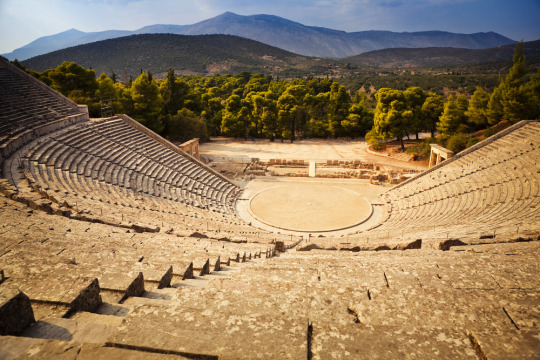
Just another day in paradise :) I must say, Polykleitos the Younger really outdid himself with this wonderful place. I swear one time I was sitting in the very back row, and a coin fell out of the dithyramb chorus leaders' pocket and I heard it clear as a bell all the way from up there!
0 notes
Photo

Ancient Theater of Epidaurus, Hellas. It was designed by Polykleitos the Younger in the 4th century BC. The theatre is admired for its exceptional acoustics. 14,000 seater.
0 notes
Text
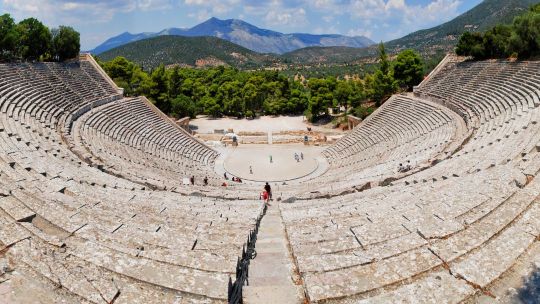
The Ancient Theatre of Epidaurus is located in the Greek city of Epidaurus. Built on the west side of Cynortion Mountain, near modern Lygourio, it is considered the most perfect ancient Greek theatre regarding acoustics and aesthetics.
The ancient theatre was constructed at the end of the 4th century BC by the architect Polykleitos the Younger. At a maximum capacity of 13,000 to 14,000 spectators, the theatre hosted music, singing and dramatic games that were included in the worship of Asclepius. It was also used to heal patients since there was a belief that the observation of dramatic shows had positive effects on mental and physical health.
Today, the monument attracts many visitors and is used to perform ancient drama plays. The first modern performance at the theatre was Sophocles's tragedy, Electra. It was played in 1938, directed by Dimitris Rontiris, and starring Katina Paxinou and Eleni Papadaki.
Performances stopped due to World War II. Theatrical performances, in the framework of the organized festival, began again in 1954. In 1955 they were established as an annual event to present ancient drama. The Epidaurus Festival continues today and is carried out during the summer months.
The theatre has been sporadically used to host major musical events. In the framework of the Epidaurus Festival, well-known Greek and foreign actors have appeared, including the Greek soprano Maria Callas, who performed Norma in 1960 and Médée in 1961.
#GoExploreGreece#greece#travel#mustsee#mustvisit#greek#europe#beautiful views#holiday#ancient site#greek blog#travel blog#lifestyle blog#greecelovers#ancientgreece#history
12 notes
·
View notes
Text

The prosperity brought by the asclepeion enabled Epidaurus to construct civic monuments, including the huge theatre that delighted Pausanias for its symmetry and beauty, used again today for dramatic performances, the ceremonial hestiatoreion (banqueting hall), and a palaestra. The ancient theatre of Epidaurus was designed by Polykleitos the Younger in the 4th century BC. The original 34 rows were extended in Roman times by another 21 rows. As is usual for Greek theatres (and as opposed to Roman ones), the view on a lush landscape behind the skênê is an integral part of the theatre itself and is not to be obscured. It seats up to 14,000 people.
The theatre is admired for its exceptional acoustics, which permit almost perfect intelligibility of unamplified spoken words from the proscenium or skēn�� to all 14,000 spectators, regardless of their seating (see Ref., in Greek). Famously, tour guides have their groups scattered in the stands and show them how they can easily hear the sound of a match struck at center-stage. A 2007 study by Nico F. Declercq and Cindy Dekeyser of the Georgia Institute of Technology indicates that the astonishing acoustic properties may be the result of the advanced design: the rows of limestone seats filter out low-frequency sounds, such as the murmur of the crowd, and also amplify the high-frequency sounds of the stage.
0 notes
Photo

Theater at Epidauros
Year: 380–360 BCE
By: Polykleitos the Younger
Era: High Classical
The theatre provides insight into the technological factors and aspects that began to take shape during that time period regarding the engineering advancements. This leap forward was used as an example of dominance as it was able to send a message to outsiders regarding the advancements the nation is making. The theatre is able to hold 14,000 attendees and is built on a hill in order to support the height of the theatre, to allow individuals on top to have a clear image to the center of the stadium. It also touches on the growth of acoustics, which is one of the main reasons the theatre is still prominently used in Greece today. The Greek systematically used whatever they could to assert dominance, whether it be through technological advancements, or political superiority, they were able to make their message very clear.
0 notes
Photo
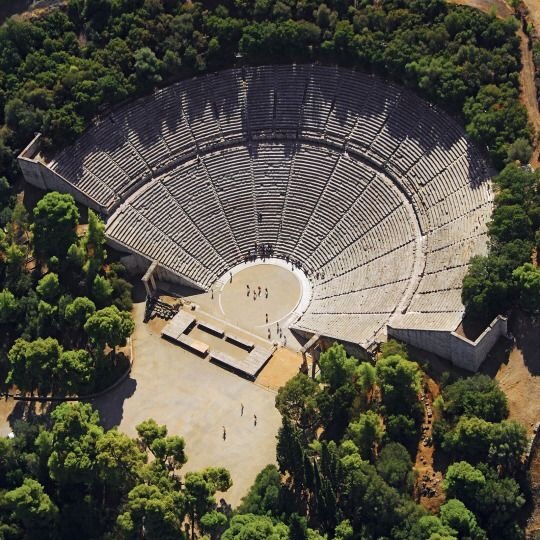
Ancient Theater of Epidaurus, Hellas. It was designed by Polykleitos the Younger in the 4th century BC. The theatre is admired for its exceptional acoustics. 14,000 seater.
1 note
·
View note